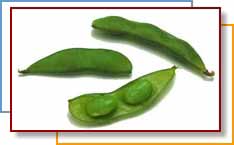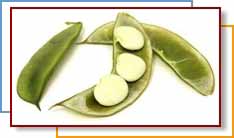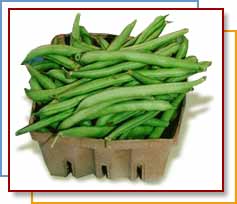
Fresh beans are classified into two basic categories: edible pod beans
and shell beans. Green beans, otherwise known as snap or string beans, are
the most popular edible pod bean in the United States. The lima bean is
the most common shell bean sold in the United States.
Edamame, a shell bean, is also called an immature green soybean. The
popularity of this bean has grown in the past decade and is now easily
found frozen in most major supermarkets.
|
|
Fresh Beans |
Serving size
1/2 cup cooked (63g)
| Amounts
Per Serving |
% Daily
Value |
| Calories
20 |
|
| Calories
from Fat 0 |
|
| Total Fat 0g |
0% |
| Sodium
0mg |
0% |
| Cholesterol
0mg |
0% |
| Total
Carbohydrate 5g |
2% |
|
Dietary Fiber 2g |
7% |
|
Sugars 1g |
|
| Protein
1g |
|
| Vitamin A |
8% |
| Vitamin C |
10% |
| Calcium |
2% |
| Iron |
2% |
* Percent Daily Values are based on a
2,000 calorie diet. |
|
| |
|
Edamame
Edamame is of Chinese origin and was developed in Japan especially for
eating out of the pod. Edamame is a variation on the same yellow and black
field soybean that is transformed into many popular soy products such as
tofu, miso, and soymilk. However, because of its recent introduction into
the U.S. market, only a small percentage of U.S. soybean fields are
devoted to growing edamame.
Some call edamame the super or wonder vegetable because it is the only
vegetable that contains all nine essential amino acids. This makes edamame
a complete protein source, similar to meat or eggs. Edamame also contains
isoflavonoids. They are found in all soy products and are being studied
for their health benefits.
Availability: Edamame is rarely sold fresh, but is available frozen
all year.
Preparation: To eat beans right out of the shell, boil them until
they are al dente (still slightly firm). Rinse to cool slightly, and
season as desired. You can easily suck the al dente beans out of the
shell. Beans may also be shelled and added to other dishes, such as
salads. Beans are easy to shell after they are boiled briefly.

Green Beans
These beans are often called string beans because years ago a fibrous
string ran along the seam of the bean. The string was noticeable when you
snapped off the ends. The snapping noise is the reason for its other
nickname.
Availability: Fresh green beans are available all year, with a peak
season of May to October. Green beans are also available canned and
frozen.
Selection: It is best to handpick green beans from a market that
sells them loose. To ensure uniform cooking time, select beans of similar
size and shape. Choose slender beans (no thicker than a pencil) that are
crisp and free of blemishes. The beans should be a bright green color. Do
not purchase beans that are stiff or have the seeds visible through the
pod because those beans will be tough.
Storage: Keep green beans dry in a perforated plastic bag in the
refrigerator. They should stay fresh for 4 to 5 days.
Preparation: Wash beans thoroughly in clear, cool water. Beans can
be cooked whole, cut crosswise or diagonally, or French-cut (i.e., cut
along the length of the bean). If you want sweet tasting, crisp fresh
beans, cut them as little as possible. Cut older, more mature beans in the
French style (i.e., lengthwise).
Stir-frying is one of the easiest ways to prepare green beans. This method
maintains more nutrients than other cooking methods. Whatever cooking
method you choose, remember to cook beans as little as possible, using the
least amount of water possible.
Boiling, steaming, and microwaving are other common methods for preparing
green beans. When boiling, beans may release some nutrients into the
water, so try to re-use the bean water to regain some of the nutrients
lost. For example, you can use the water to boil rice.
TIP: Green beans continue to cook after you take them out of
the boiling water. Either take them out just before they are cooked
the way you like, or plunge them into ice water immediately to stop
them cooking further.
|
TIP: The fewer beans in the pan, the quicker they cook and
the better they taste. If cooking more than one pound at a time, use
separate pans. |
Lima beans originated in Peru and have been grown there since 6000 B.C.
The name lima bean comes from the capital city of Peru, Lima. Lima beans
are often nicknamed chad beans or butter beans. In the southern part of
the United States, lima beans are almost always called butter beans, even
in markets and restaurants.
 Varieties: Lima beans come in three main varieties: large, small,
and dwarf. Varieties: Lima beans come in three main varieties: large, small,
and dwarf.
Large lima beans are green or speckled. The speckled kind have a creamy
texture and a strong earthy flavor, unlike the pale green ones.
Small lima beans are also called sieva beans and have several other
nicknames, such as Carolina bean, civet, seewee, and sivvy. Most small
limas are pale green. Small limas are less starchy than the larger
varieties.
Dwarf beans, also known as butter peas, are white and speckled and the
least starchy of the limas.
Availability: Fresh lima beans are difficult to find in the United
States, but can occasionally be found at farmers markets. It is easier to
find lima beans in the southern United States than anywhere else in the
country. Most lima beans are dried, canned, or frozen.
Preparation: Fresh lima beans need to be shelled before they are
eaten. Shelling can be a little tricky, especially with larger beans.
Beans are easier to handle if they are tender and have full pods. One
method used for larger beans is to simply cut open the pod with scissors
and remove the beans by hand. To remove the beans from smaller limas, pull
off the string along the seam, and press the two sides open to pop the
beans out. Rinse canned limas before using them to reduce their
gas-promoting properties.
Lima beans should never be eaten raw (see warning below). The most common
methods of preparation are boiling and microwaving. Only a small amount of
water needs to be used for either method.
|
WARNING: Do not eat raw lima beans. They contain linamarin
(also called cyanogen), which releases a cyanide compound when the
seed coat is opened. Don’t worry; cooking deactivates this compound.
The United States sets regulations to restrict commercially grown
lima beans to those varieties with very low levels of this linamarin,
but lima beans grown elsewhere, may have 20 to 30 times the
concentration allowed in the United States. (Source:
www.foodreference.org*) |
Recipes
 Lemon-Walnut
Green Beans Lemon-Walnut
Green Beans
Makes 8 servings
Each serving equals 3/4 cup of fruit or vegetables
Ingredients
8 cups small green beans
cooking spray
2 cups sliced green onions
1/3 cup chopped walnuts
1½ Tbsps chopped fresh or 3/4 Tbsp crushed dried rosemary
5 Tbsps fresh lemon juice
1½ Tbsps grated lemon rind
Arrange green beans in a steamer basket over boiling water. Cover and
steam 8 to 12 minutes or until crisp-tender. Plunge beans into cold water
to stop the cooking process; drain.
Spray a sautè pan with cooking spray. Over medium-high heat, add green
onions, and sautè until tender. Add green beans, walnuts, rosemary, and
lemon juice; cook, stirring constantly, until thoroughly heated. Sprinkle
with lemon rind.
Nutritional analysis per serving: Calories 74, Protein 3g, Fat 2g,
Calories From Fat 24%, Carbohydrate 11g, Cholesterol 0mg, Fiber 4g, Sodium
10mg.
Find more in our
recipe database!
|



